Our Goal
Over time our plan is to develop a history of farming from all over Clackmannanshire. However we have to start somewhere. Our initial information comes from a text written by The Rev. Peter Balfour, Minister of the Parish of Clackmannan for the new Statistical Account of Scotland (written in 1841), and also from local farmers. The Statistical Account text has lots of interesting information within it, therefore we will make the text available elsewhere in the website.
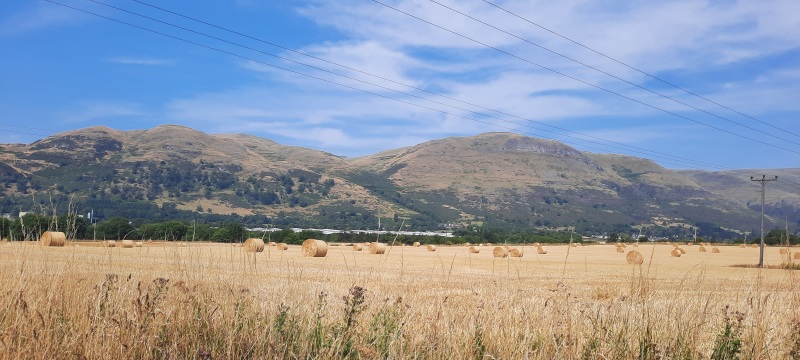
The Ochil Hills Over Alva
Background on farming
As long as there has been people living anywhere in Clackmannanshire, there has been, on some scale or format, some kind of farming. Originally it would have been to provide a family, tribe or clan with adequate food supplies to compliment the fish or meat that will have been caught locally.
In several sites across Clackmannanshire, archaeologists have found evidence of early Neolithic settlements. This era is generally dated at around 4000BC. Pottery remains, post holes and fire pits, as well as charred plant waste were all found on Meadowend Farm, Kennet when an archaeological dig took place there. Similar evidence of early Neolithic life has been found at various points throughout the county. This is the era when agriculture was first identified in any recognisable form.
Over centuries, farming gradually changed and the farms will have started to appear more in the form of land cleared and used purely for growing grains and vegetables, as well as a place where animals would be kept for more than just meat, i.e. for milk, skins, wool etc.. As the farms enlarged it became customary for local people to buy or barter for produce. The increasing farm size would also have eventually lead to local people working on the farms as they became too large for just the farmer's family to work on alone. This local workforce would initially have helped bring the harvest in annually, with some of the jobs slowly becoming more permanent. Ongoing work such as land clearance and improvement, boundary walls and fences, drainage and tillage of the land may all have required skilled labour to assist the farmer.
Early farm employees were often paid in produce as well as small amounts of money. Often, workers were given their meals whilst at work on the farm. As time passed, farmers began to give the permanent workers homes on or near the farm, either rent free of for a very cheap rent as well as produce and an improved wage. As centuries fell away into the dim past, many farm skills became increasingly specialised, such as shepherds, dairy maids and ploughmen.
A view of farming in 1700's
After the Union with England in 1707, the Nobility and Gentry made an effort to start making improvements with farming in Scotland. Up until this point farms were generally small and farming was all hard labour with little reward, families were scarcely able to feed themselves and their animals at times. To help finance their farms and families some farmers would move coal for the collieries, which paid them relatively well. Tenant farmers generally paid a rent for their farm as well as kain (paying in kind) and cess (tax), some farms also had to help pay for local facilities too, for example the farmers of West Cambus helped pay for the local School Master. At the start of this century many small farmers paid their rent by payment in kind especially within the Alloa Parish where they would pay their rent in produce, time or skill. Paying in kind was a problematic way to pay their rents in “bad” farming years, as if the farmer could not fully pay in kind they would usually have to carry the debt into the new year and have to work even harder and hope that they had a good harvest that year to pay the previous and presents years rent in full. Later rent was paid primarily in money.
Previously there had been free pastures, this was when animals could wander around the countryside grazing wherever they wished, farmers might also be leased patches of land separated by other farmers land, making working the farmland more time consuming as they may have a significant distance to travel between patches of land. During the 1700s this changed as tenancies came up for renewal. The landowners amended which areas farmers were rented and resulted in the introduction of Enclosed Farming, where the boundaries were generally walled or fenced. Then the land split into fields usually by building a stone and lime wall to approx 2 ½ foot in height, the wall would be built beside thorn bushes which would increase the height of the perimeter over time increasing the security of the stock. Within the new enclosed farms, the farm buildings and the residential buildings were usually kept separate on larger farms.
There were generally two types of workers on farms, those who had full time work, , these workers usually received a house on the farm either free or for a small rent as well as produce and cash. The farmers showed a preference to employing married men for these jobs as they deemed them more steady, orderly and tractable. The other workers were those who may only receive work for a day, week or task. They generally got paid in cash, occasionally getting food and accommodation, this generally occurred at harvest season, as workers would work long hours and so staying on the farm meant they could work longer each day as they didn't have to travel each day to work. When the farm was especially busy families of the workers could work and receive payment as well.
At the start of the century poorly constructed “carts” scarcely the size of a wheelbarrow were used in the fields. Later larger carts drawn by two horses were used and in harvest time they could carry great loads of up to 100 stone tron weight (approx 18cwt) of well made hay. Lord Kames, known as the Gentleman Farmer however recommended that a one horse cart was more profitable and farmers began to change to this cart.
Towards the end of the century farmers were chiefly using ploughs of Smith's Construction which had an iron head and cast iron mould board. These typically cost 2L to 2L 10s according to the weight of iron used in its manufacture. These ploughs became popular as they could easily break up the heavy soil especially the clay soil that was often found within the county.
New varieties of crops were introduced including Turnip and Cabbage, at the same time as new methods of working with the land, for example adding lime to the soil. The Potato was introduced in 1739 and improved the diet of all, but especially the poor. Clackmannanshire is made up for various different types of soil and therefore what could be grown varied across the county as did what animals could be kept. The land along the banks of the River Forth are mainly Carse lands with varying qualities of soil, as a general rule the further you go from the River the poorer the soil became until you reach the foot of the Ochil Hills, where in some areas the quality improved again. The “inches” in the River Forth just south of Cambus were often used for grazing cattle in the summer months.
Once the new equipment and methods arrived in the area, the quality of soil throughout the county improved as did the output and quality of the crops. Many farmers followed the example of a farmer who moved to the area from East Lothian, as he ploughed, drained and dressed his fields his neighbours would learn from him and start to copy him, and their neighbours would then copy them. He suggested to his landlord, Lord Alva that they should hold “Ploughing Matches” These were established in 1784 and within seven years there were forty competitors attending matches. These matches helped spread the new ways of working the land even further.
There was no particular crop rotation pattern in the area, but slowly farmers seemed to revert to pretty much the same one, which was:-
Year 1 – Fallow
Year 2 – Wheat
Year 3 – Beans & Peas
Year 4 – Barley & Grass Seed
Year 5 – Hay
Year 6 – Hay (Pastured)
The land then left in pasture for up to five years then broken up for oats.
Towards the end of the century it is noted that there were six thrashing mills in the county and these were used by many farmers to deal with the thrashing of crops (separating the edible part of the crop from the straw). Mr George Meikle of Kilbagie developed the some of the first thrashing machines and installed several within Clackmannanshire.
The rents were considerably increased throughout the century, although not excessively, the prosperity of the industrious and intelligent tenants plainly demonstrated in their better standard of living, better quality of livestock especially their horses and the improving quality of their machinery.
When a farmer was taking on land of a poor quality they often got two 19 year leases, this was due to the fact that they would have to put a lot of time and money into improving the quality of the soil when they first took the farm on. The first lease was usually a notably smaller rent than the second lease as they wouldn't be expected to make much money for a considerable period of the first lease. Once the second lease began the farmer should by then be making considerably more money from the land so was able to afford the increase.
Throughout the County there were several Tree Plantations which generally consisted of Oak tree's, which seemed to thrive in the local soil and climate.
Livestock throughout the County varied, within the Alloa Parish there were very few animals kept, despite a ready market for dairy produce within Alloa. Other areas of the county could support different animals, the Ochil Hills has always been a good place to graze sheep. Some of the local farms would buy Tweeddale Black Faced Sheep, while others would breed their own which tended to be generally better, stronger and more profitable for them. Towards the end of the century there were approx 3500 sheep over five farms in the Tillicoultry Parish. Cattle would generally be kept on land between the Ochil Hills and the River Forth.
It is of note that throughout the 1700's there were no markets where farmers could easily reach to sell their grains. Some of the farmers would go to the Mid-Lothian and Haddington Fayres to sell their grains. The hay produced in the County was larger sold to the local collieries who used considerable quantities. The farmers realised that it is better to cut the hay earlier as it is heavier and as they sell it by weight it was profitable. The early cutting of the first crop also meant that the second crop of the year was ready earlier in the year.
In 1792 farmers struggled to make sufficient money from their crops due to this being an unprecedented wet year, therefore the crop yield was there. This meant many could not afford to pay their rents, buy feed for the animals or support their families. Considerate Landowners decreased the rent due from their smaller farm tenants and allowed longer for the tenants on the large farms to pay their rents.
In 20 years the number of farms in the county decreased as farm sizes were altered and tenancies came to an end.
A view of farming in 1841
The land was split into three types primarily assessed by its distance from water. Due to the Rivers Forth and Devon's presence certain areas of Clackmannanshire were, and still are susceptible to flooding. Due to the River Forth flowing into the sea, it has a relatively high salt content, and so the amount of water was not the only problem for farmers. The salt content in the water can damage the crop as well as the field soil for lengthy periods of time.
The land types are:-
Careseland
Good Dryfield
Inferior Dryfield
These lands would be rented by tenant farmers and the price per acre varied on the type of land and its use. The rental for grazing was charged per animal for a season. Other than on the Ochil Hills where sheep were generally kept, it was usually cattle and oxen that grazed the land.
The fields on either side of the River Devon had their drainage improved using either stone or tile in a variety of place to help increase the available acreage for crops and animals.
The three hills above Alva had now been divided into two sheep farms. The farmers still tended to buy Tweeddale Sheep which they bought around Midsummer at the Linton Markets when the livestock was one year old. The farmers also breed some young lambs but these were by far the minority. The hills and forests provided ideal shelter for the flocks over winter.
The quality of the Clackmannanshire had in most places improved drastically after the improved techniques adopted throughout the 1700's. This meant that farmers who continued to care for their land continued to benefit from increased yields of crops. The crops mainly grown in the county by the 1800's were oats, barley, turnip, potato, peas, beans and clover (used for horse grazing).
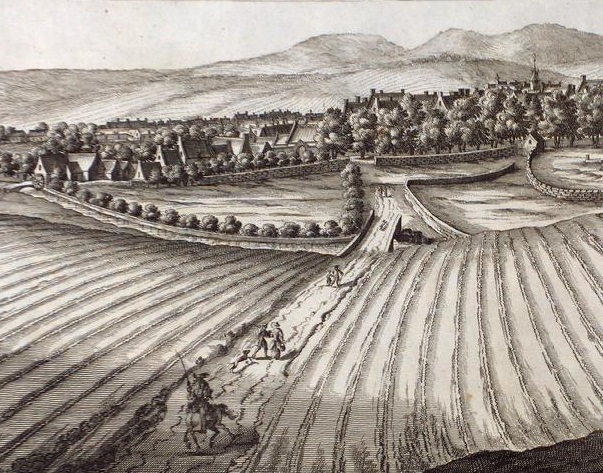
1800's Countryside
Farmers in 1841 who locally grew barley were in a very fortunate position due to the number of breweries in the area. The breweries required vast quantities of barley and had to ship a lot into Clackmannanshire as our own farms couldn't fill all their needs. Due to this demand, local farmers could charge per tonne of barley the equivalent to the cost per tonne of barley plus the shipping costs per tonne of the imported barley.
Twentieth and Twenty-First Century Farming
Presently there are thirty-five farms listed in Clackmannanshire and we had the pleasure of meeting some elderly farmers from the area, Mr. and Mrs. Cuthbertson and Mr. Hendry, all three are from farming families and have worked on farms most, if not all their lives. I hope to bring farming from their lives to life for you. Obviously I am going to include some facts and figures but there will also be stories of their time farming, events that they know about as well as some information on how farming has modernised.
Mr Cuthbertson was born on Teeside where his Scottish father was a tenant farmer on land owned by Lord Annandale. His whole family farmed as this was still very much the normal at the time. Mrs Cuthbertson is again from farming blood this time from the Falkirk area. As many young farmers still do, they both used to attend Young Farmer Social Events, which were held in a variety of places, including the Golden Lion Hotel in Stirling, and the Victoria Hall in Dunblane to name just a couple. These events were highly anticipated and it was at one of these very social gatherings that they met.
Mr Cuthbertson was in fact a Farm Manager for the Earl of Mar and Kellie. Mr and Mrs Cuthbertson lived on and ran Inch of Ferryton Farm, which is just south of Clackmannan, on the Earl's Estates.
Mr Hendry's family farm was Blackgrange near Cambus, where they used to purchase cattle from the Scottish Islands to raise as Beef Cattle.
Types Of Farming
Clackmannanshire's farms are mainly cattle and crops, with a few at the Ochil Hills having some sheep. The land further away from the hills isn't really suitable for sheep, although some farmers do use lambs to help clear their fields. There are also two dairy farms in the county, much less than there use to be. Swedes are usually grown as food for the cattle or lambs. Many farmers keep a few chickens and it was traditional to have a dairy cow for their own milk, but that seems less common now.
Fortunately the last time there was foot and mouth disease affecting UK cattle, it did not come over the River Forth into Clackmannanshire.
A farming year
Springtime
Typically springtime is a busy time of year for farmers between preparing the soil for the seeds and putting the livestock out on the fields. Mr Cuthbertson recalls that when he started at Inch of Ferryton there was a man and boy employed by the farm and the tractor at the time was a Fordson Dexta. The tractor was typical of the sort used at the time, being relatively small and mechanically simple.

An example of an 1960's Fordson Dexta Tractor
They would have to tow the appropriate pieces of equipment behind the tractor to turn the soil, sew the seeds and then cover the seeds. The most important part of getting a good crop was to try and plough early in the season so as to have a good seed bed. Barley would be sewn in fields where there was a higher lime content. Other crops which would be sewn are carse beans (sometimes known as field beans) which took a long time to ripen and was used to feed the livestock, the bean would be ground down and added to each farms own food mixture for the cattle and the dried stalks were given to horses. A mix of prepared beans, oats, and swedes, were usually used to feed the livestock over winter.
As the decades passed, farming machinery became larger and more sophisticated, and more varieties of the different crop seeds became available, in many cases the seed would be cross bred with other varieties, so that, for instance, the crop didn't grow as tall as before, which made harvesting with a combine harvester easier. Other types of crops also became viable for sale - a popular one to be planted more recently is Rapeseed, which is used mainly to produce vegetable oil.
1985 was a disastrous year for the farmers locally as from the end of June until October it never stopped raining, which resulted in the harvest taking much longer as the weather had flattened the crop , therefore each crop needed the combine harvester to work in both directions across the field, in a bid to harvest as much of the crop as possible.
Irish Cattle were usually brought into Silloth or Glasgow for sale and the farmers would head there for this years herd, unfortunately the Irish farmers stopped bringing their stock over for sale, so the farmers ended up buying domestic breeds, which tended to be less passive than the Irish cattle, as the Irish cattle were more used to human interaction. The domestic breeds were more difficult to handle as well.
Summer Time
Over the summer the hay would be harvested primarily for horses. Many of the Scottish Islands would buy their hay from Clackmannanshire, often entering into agreements where the farm selling the hay would purchase some cattle from the farm buying the hay. Often the Isles would order their hay in advance.
The weather was, and still is, the blessing or curse of the hay harvest, the years the sun shines and dries the crop is a blessing as years of rain make it extremely difficult for the farmers to dry the crop. The grass in earlier years would have been cut by a mower pulled by horses, as time moved on it would have been attached to the back of the tractor. The mower blades had to be extremely sharp, therefore the farmers would often sharpen the blades of the mowers overnight. Once the grass was cut it would have to be allowed to dry in the field where it would be turned each day. Once it was dried it would be gathered into rows with hand forks. The next stage was to gather the rows into rucks which were then piled onto a stack cart being pulled by horses, and later in the century by tractors. This tasked required a man standing on the hay as it was gathered on the cart, people on the ground would use the forks to toss hay onto the cart and he would place it.
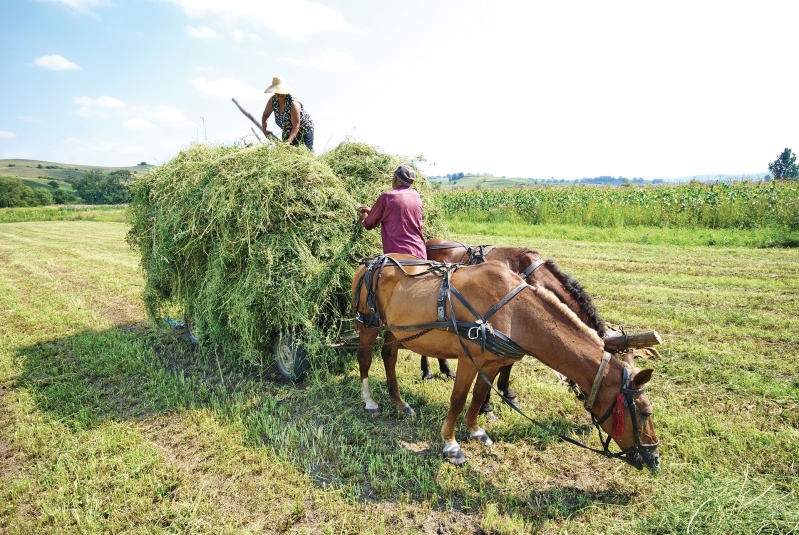
An example of Stack Cart and Horses
Once the cart was filled it was taken back to the farm yard and grouped into stacks, these would then have a thatched covering made on the top of them to help protect them from the rain and keep the hay dry until needed. The stacks were also tied initially with wire but this changed to rope. The processes of thatching and roping would take another two weeks. This people driven harvesting was very hard work and many farmers employed local people as well as having his family working on bring the harvest in. The farmers wives would ensure everyone working on the fields was well fed between sandwiches, home baking and meals.
Today Combine Harvesters do many of the jobs related to harvesting all at once, meaning that the temporary employment is no longer available on the farms for locals during the harvest. The modern mowers which initially cut the grass also shave the ground very closely meaning that less of the stalk is left in the field, and subsequent field cleaning is minimised.
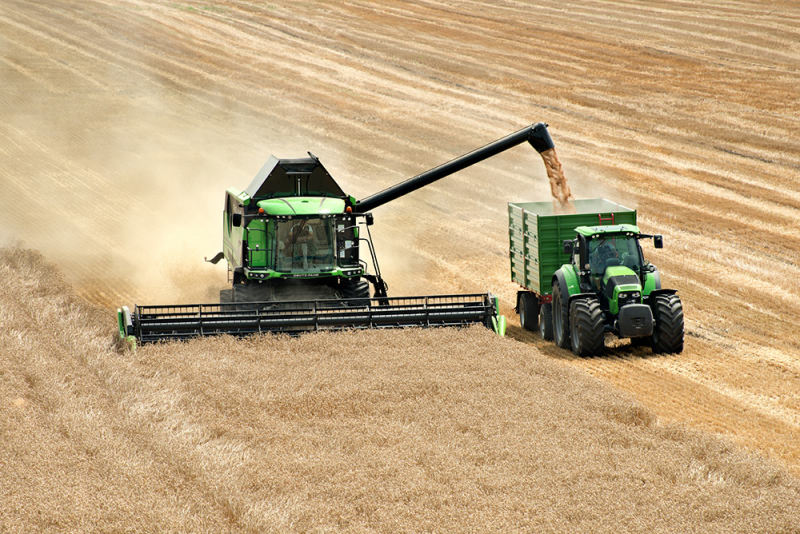
Example of a modern Deutz-Fahr Combine Harvester
Autumn (Harvest) Time
As the year moves on so does the farmers jobs, as autumn arrives it is time to harvest other crops including the oats and corn, these are gathered and stacked, many of the older combine harvesters couldn't cope with the oats harvest but this has changed over time and now the combine harversters can cope with most farming crops. The use of combines means that the crop isn't now dried in the field, so farms now have to have driers available which dry the crop once gathered. Modern crops have very specific moisture levels that are acceptable for sale usually around 12-13%.
Before combines, the farmers had to have their crop thrashed, this was either in a thrasher machine on the farm or in a local thrashing mill. If it was on the farm the days that thrashing was happening were extremely busy for everyone on the farm. The stacks would have to be forked up to the man on the thrashing machine who would put it through the machine. On these days it was again important that the farmer's wife made sure everyone was well fed so that the work was done as quickly as possible. When necessary she would also go out and help fork the crop to the thrasher man.
When combine harvesters became a regular tool on the farm, the yields achieved from crops gradually increased as the combines improved.
Mr Cuthbertson grew a small amount of potatoes on the farm as well, these however were for the use of the farmer and farm staff.
Sometimes more cattle would be bought to augment the stock.
Winter Time
In the winter the biggest job on the farm throughout time is to make sure the livestock are sufficiently fed, this is where some of the crops grown earlier in the year are needed. On the Inch Of Ferryton Farm, Mr Cuthbertson had a man who spent most of his days mixing the feed for the animals. This included grinding the carse beans, chopping the swedes and bruising oats to then be mixed for feed.
Drainage issues are also often addressed over the winter time. At the Inch of Ferryton Farm this included installing new drainage pumps and building a housing for them.
Obviously winters can be hard or easier for farmers, yet again determined by the weather. If we have a milder and relatively dry winter the animals will need slightly less care, especially if they are able to graze out in fields which have been reserved for winter grazing, usually nearer the farm or on the hills. If it is a snowy winter and there are any animals out in the fields, farmers will obviously have to check the animals are safe especially if there is a deep snow fall. Rainy and cold winters other than being miserable to work outdoors in, is the time when any drainage issues will reveal themselves, potentially meaning the farmer has to install more field drainage.
Geographical Issues
With both Inch of Ferryton and Blackgrange Farms being close to the River Forth, the farmers have lived with the constant threat of flooding. This is despite the raised river bank defences, which were built using Prisoners of War from the Napoleonic War (1803 – 1814) at some point during their imprisonment at the nearby Valleyfield Prison in Fife.
Mr & Mrs Cuthbertson recalled how in 1985 the river Forth passed the top of the river banks and started flooding the fields between their farmhouse and the river. The farmhouse was sitting on a slight raise in the ground, but to be safe they moved their furniture to the upstairs of the house. Within 30 minutes the farmhouse was sitting on a small island surrounded by floodwaters. Mr Cuthbertson described a roaring noise just like that of the Niagra Falls as the water rushed over the riverbank.
The river water also caused problems with the soil chemistry, because after the river overflowed into the fields, as it drained away or dried up there would be salt left in the soil, making it useless for some of the crops.
The heavy clay soil of the land around the Forth means the soil holds moisture well, so in long hot summers the soil is less likely to totally dry out and therefore the harvest has a better chance of succeeding.
World War II
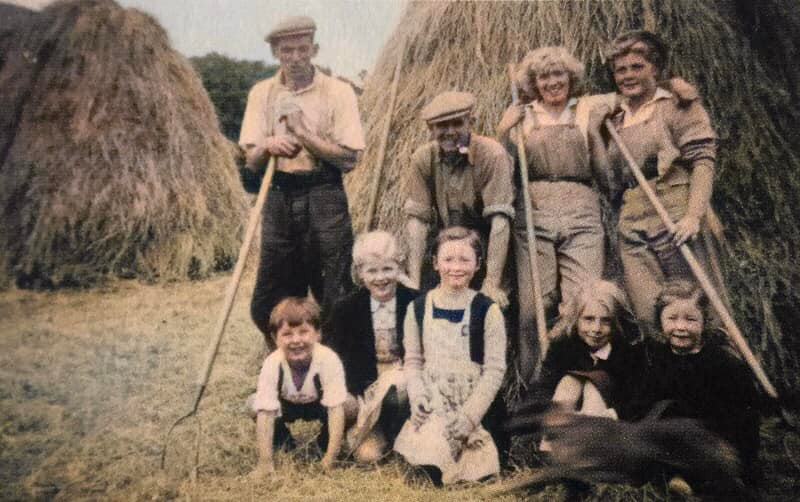
Haugh Farm near Dollar, 1945 Land-girls, Farmers and possibly local and refugee children
Clackmannanshire farmers, like farmers all over the UK were affected by World War II, many of the younger male workers would go and sign up for the military forces even though they would not be forced into the military, as farming was an exempt occupation, similar to coal mining. Just at the time workers were leaving the farms, the Ministry of Agriculture were encouraging farmers to plant in every viable scrap of land they had so that the nation could be fed. Some farms received 'Land Girls*'. Some of these girls were country girls who at the very least had some idea of what they would be doing and an understanding that it was going to be hard, dirty work. Unfortunately some of the girls were from cities and bigger towns and had absolutely no idea of what was involved in farming, but usually after a shock to their systems for a few weeks they adapted and started to enjoy the country life and the bonus of plentiful vegetables and fruit. Locally we know of one Land Girl Hostel called Woodside, which is just outside Cambus on the main Stirling to Alloa road. There would be 6 girls sharing each room. The house can still be seen as you travel towards Stirling and is the first property you come to on the left hand side as you approach Cambus.
*The Women's Land Army was founded in 1917 to help farmers cope with the shortage of male labour that resulted from the First World War, by recruiting women to work the land. Its members were affectionately known as the Land Girls. Sceptics did not believe that women would be suited to the hard labour that farm work required. But the land girls played a critical role in supporting the country’s food production during the First World War. The organisation was re-established in the Second World War, and by 1943 its members helped produce the vast majority of Britain’s wartime food.
In areas where there were Prisoner of War camps, some farms were given prisoners to help work their land. Both gentlemen remember prisoners working on farms around them. There was a Prisoner of War camp near Fishcross, and Mr Mailer recalls the Italian prisoners and Displaced Polish working on the farms. Mr Cuthbertson at this time was still living in the north of England and recalls Prisoners from the Featherstone Prisoner of War Camp* in Northumberland working on the local farms.
*Featherstone Park POW camp, Camp 18, was located in the grounds of Featherstone Castle, near Haltwhistle, Northumberland. It opened in late 1944, housing Italian POWs, and later, German Officers.
Farming Equipment
During their working lives the farmers have seen many changes, some for the better, others not so. Smaller farms have become quite solitary places, as much of the modern machinery has done away with the need for multiple people with different skills, or simply to complete a task quickly. The modern tractors and combine harvesters are all very computerised and often only need the one solitary worker there to complete the task at hand. Although in some ways this is great for the farmer, as harvesting may be much quicker and more efficient it also has numerous downfalls. A piece of equipment which breaks down now has to be repaired by a specialist rather than the farmer being able to mechanically fix it himself, as was often the case previously. This also means that instead of a tractor being out of use for maybe a few hours it could possibly be weeks before a specialist can come to repair a modern tractor, assuming they can fix it first visit. This also means that modern farmers tend not to have the same skill set as their predecessors, who would have to at least try and fix problems themselves, whether it be machinery or building etc. In modern times the These highly computerised pieces of equipment might also be very off putting to more elderly farmers or farmers who simply don't like technology “taking over”, potentially causing farmers to leave the industry.
The Health and Safety Executive have in more recent times, introduced rules which force farmers, and many others to do things in a specific way or get a specialist in all the time.
Movement Of Animals
Mr Mailer Hendry recalls when he would “Drove” the cattle from the Islands on foot down to his family farm a walk of approximately 120 miles, therefore 12 days of walking if the conditions were idea and the cattle could cope with the preferred pace of 10 miles per day. The weather would obviously be the deciding factor on how quickly the walk was made as in hot weather the cattle and drover would need to drink more and walk slower due to the heat. Whereas bad weather may prevent the crossing from the island if there were strong winds the ferries may be cancelled. Heavy rain and strong winds would also cause problems whether it be rockslides on roads, blocked roads with water or trees, and head on winds would all slow the walking pace. Anyone who Drove cattle had to have a good understanding of the cattle's needs, as only by doing so would the cattle arrive at the farm or market in a good, healthy condition.
If a Drover tried to walk the cattle too fast they would start to lose weight and tire, unfortunately this would at best result in the cattle arriving at their final destination worth less than when they started or at worst the death of cattle along the walk. A good Drover had to follow the cattle's walking pace, and would know the best places to rest for the night and to allow the cattle to graze. The cattle would usually walk approximately 10 miles per day and if walking a very long distance , for example, to London, the cattle would have shoes put on their hooves.
Mr Hendry recalls having to swim between islands with cattle if they had missed the ferry. Amazingly if you can get a few of the cattle to start swimming the rest will just follow on, it goes without saying that any Drover doing this would have to be a good swimmer or hope the water wasn't very deep. It seems that one of the hardest parts of the job was trying to keep the cattle away from all the tasty plants and flowers in unfenced gardens as they passed by. Seemingly cattle are relatively vain animals to, as they like to look at their reflections in windows.
Unfortunately we no longer see the cattle being driven through towns and villages as they once were, I'd imagine it would have been a wonderful sight to see, instead these days we see large lorries driving along with the cattle in specially designed trailers. As they pass by we might be lucky if we see the cattle's eyes through the ventilation slats, otherwise its usually their rears. Due to the availability of such trailers transportation of the animals is a lot faster and no longer requires an experienced cattle man who can tell the animals needs. Instead its a driver taking them from point A to B probably over only a few hours instead of the days that were required in the past.
Cattle Markets
In earlier decades locally, the Thursday Beef Market at Stirling was always a big day for all the Beef farmers, this was when they would buy new cattle or sell their cattle. Before the farmers would go to the market they usually dropped their wives into the town. The farmers would then head off for a good day at the the Cattle Market in Wallace Street, which usually involved catching up with old friends. The Stirling Market was usually where Irish Cattle were sold as they were a bigger cattle and not many markets had the facilities to deal with them.
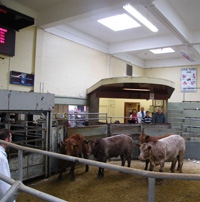
Kildean Market, Stirling
Meanwhile the wives would head into town to do the shopping and on some occasions meet up for a cuppa and a catch up. Unfortunately for the women they would sometimes be standing at the pre-arranged pick up point for quite a while after the shops shut if the men folk were too busy talking and had lost track of time.
Unfortunately the farmers markets locally are no longer as busy these days as most of the beef cattle now is already contracted to ScotBeef Ltd. Undoubtedly wonderfully reassuring to the farmers that they will get a good price per head but such a shame to think the hustle and bustle of a Thursday is no more.
Royal Highland Show
The Royal Highland Show is a favourite event that happens in Edinburgh at the Royal Highland Centre in Ingliston near Edinburgh. This event occurs every year and the funds raised helps support the Royal Highland & Agricultural Society of Scotland. The Show is attended by many members of the public, not just farmers, and is a very popular summer event. Before the Show found a permanent home at Ingliston, it used to travel around the country each year. It was held in Alloa on three occasions - these were in 1929, 1937 and 1953.

The poster for the 1929 show.
The show in 1953 was sited on land between Alloa town centre and the River Forth (commonly known locally as the “Bottom end”.
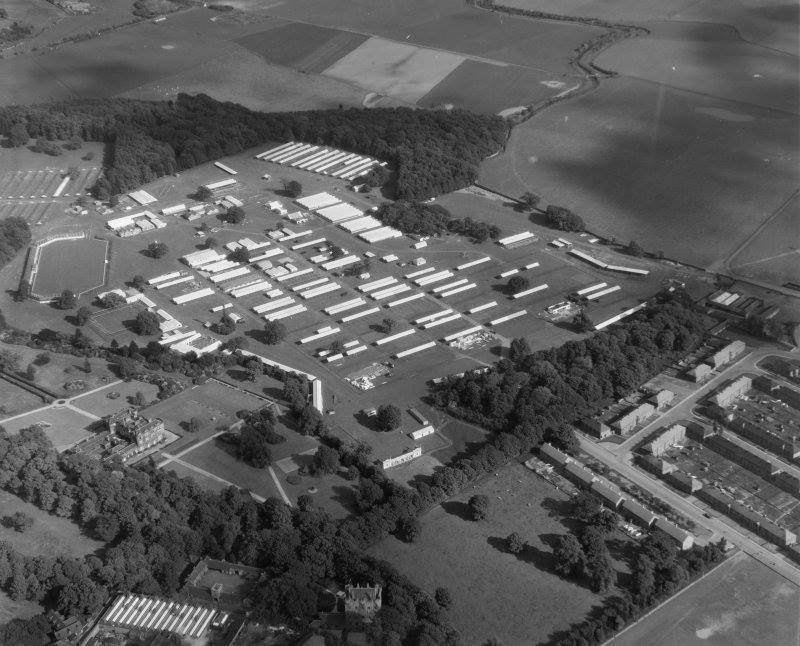
Aerial view of the showground, note Alloa House on the left.
This show had as one of the visitors the Royal Canadian Mounted Police the otherwise world renowned “Mounties”.

A picture printed in the Scottish Farmer of the Canadian Royal Mounted Police at the Alloa Highland Show in 1953.
The 1953 Show provided a thoroughly good day out with as always plenty of food and drinks available, they also provided a Crèche facility for when the youngsters got tired, allowing mum and dad to continue enjoying their day while the little ones were safely looked after.
Just seven years after Alloa's last show, the Royal Highland Show took up permanent residence at the Royal Highland Show Ground, which had been bought and specifically set up to host the Show each year.
Acknowledgements
I would like to give thanks for the important contributions to this text, given freely and with great humour, by Mr James Cuthbertson, Mrs Elspeth Cuthbertson and Mr. Mailer Hendry.
Agnes Neeson.
